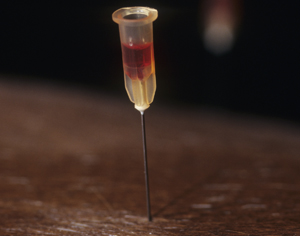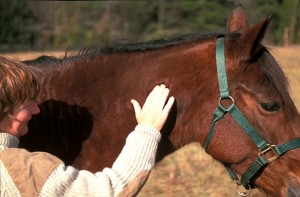Alternative therapies are in. Herbs for your horse’s skin rash, acupuncture for his sore back?no matter what ails him, someone is sure to tell you about a fantastic treatment that can fix it. Silver bullet, snake oil or something in between? Getting answers can be a challenge. Unlike conventional treatments, most of these therapies haven’t been thoroughly researched.

In this article, practitioners familiar with some popular alternatives explain their uses and help sift through the claims, cautions and costs. We’ll also tell you which treatments have been tested in clinical trials, the gold standard of “evidence-based” medicine. Armed with that information, you’ll be able to decide what’s right for your horse.
Some alternative treatments should be done only by trained and licensed professionals, notes Joyce Harman, DVM, a holistic veterinarian who has used acupuncture, homeopathy, chiropractic and herbal medicine alongside conventional treatments in her Virginia practice. Others are safe to try on your own. But never forget that, while some of these therapies may complement conventional veterinary care, none can replace it. If your horse is sick or seriously injured, he needs a veterinarian first.
Acupuncture
Acupuncture, used in China (on horses and humans) for more than 3,000 years, is based on the idea that stimulating specific points on the body can have beneficial effects. Traditional Chinese medicine holds that currents of energy (qi, or chi) flow through the body along pathways called meridians. “Points on the pathways act like dimmer switches,” says Dr. ?Harman. “If they’re partly blocked, the flow of energy is disrupted and the body doesn’t function properly. Acupuncture is like turning the switch on.”
Conventional Western science offers a different rationale?acupuncture stimulates the nervous system and prompts the release of body chemicals, including endorphins, which ease pain, improve circulation and relax muscle spasms.
Treatment: In traditional “dry needle” treatment, the acupuncturist inserts thin sterile needles at selected points, sometimes twirling the needles to increase stimulation, for 5 to 30 minutes. Variations include:
- Biopuncture: A sterile solution (usually vitamin, saline or homeopathic) is ?injected at the acupuncture points, providing lingering stimulation.
- Electroacupuncture: Mild electric current passes through needles at specific acupuncture points to stimulate a larger area and to provide more pain relief.
- Cold (low-intensity) laser stimulation: This doesn’t break the skin.
- Acupressure: This massage technique focuses on acupuncture points.
“There are a lot of people selling treatments with all kinds of things, shining lights on acupuncture points and so on,” says Dr. Harman. “Many are less ?effective because the stimulation isn’t strong or the practitioner isn’t skilled?but most are not harmful, except maybe to your checkbook.”
What it does: Acupuncture is best known in the West as a method of drug-free pain relief, and that’s mainly how it’s used in horses. Behavior ?improvement can be a benefit, whether directly from treatment or from pain relief. Some practitioners use acupuncture in diagnosing and treating certain illnesses, but in most cases pain relief is what you should expect.
Evidence: Several small clinical studies have shown that acupuncture and electroacupuncture help relieve equine pain, including back and foot pain. Some studies found evidence of endorphin release. Researchers haven’t found clear evidence of distinct meridians or qi.
Red lights: If needles aren’t sterile, infection can develop at insertion points. There’s also a risk of overlooking, and perhaps masking, an underlying problem that needs conventional treatment. Avoid both risks by working with your veterinarian and choosing a certified veterinary acupuncturist.
Where to find it: By law, only veterinarians (or, in a few states, trained acupuncturists under veterinary supervision) can administer acupuncture. The ?International Veterinary Acupuncture ?Society certifies veterinarians; its Web site (www.ivas.org) is a good source for finding a practitioner.
What to expect: Look for some ?improvement in two to four sessions. If you don’t see it, you may be working with the wrong diagnosis, the wrong treatment or the wrong practitioner.
Cost: Anywhere from $90 to $200 per treatment, depending on the practitioner. An experienced practitioner may charge $250 for a session that combines acupuncture and chiropractic treatment.
Chiropractic
Chiropractic treatment mainly addresses problems that originate in the back, neck and pelvis. These problems may show up as a sore back, a subtle lameness, resistance or performance issues. They typically develop after an injury or a poorly fitting saddle or from another cause that restricts ?motion in the spinal column. These lead to muscle spasms and inflammation in the joints of the spine. Ultimately, the health of the joints begins to decline.
Treatment: The practitioner does a hands-on exam, looking for soreness, tight muscles and areas of restricted motion
in the neck, back and pelvis. Joints with restricted motion are usually adjusted by applying hand pressure directly to the area in quick, firm thrusts.
What it does: The main goal is to restore full motion in the joints. Treatment won’t reverse existing damage, but it can help prevent further damage and make your horse feel better.
Evidence: There are few studies of chiropractic treatment for horses, but limited research has shown that it can be helpful in treating back pain.
Red lights: Chiropractic treatment should not be used for fresh injuries with bruising and muscle damage, or if there’s any chance that your horse has a fracture. Serious illnesses and injuries must always be treated by a veterinarian.
Where to find it: Veterinary chiropractic care is widely available, but not all practitioners are equally skilled or trained in treating horses. Improper treatment can injure your horse, so:
- look for a chiropractor certified by the American Veterinary Chiropractic Association (www.avcadoctors.org), specifically trained to work with horses?and licensed to practice in your state.
- get recommendations from your veterinarian, trainer and others whose opinions you respect.
- watch the practitioner work?your horse should relax during treatment and seem to enjoy it.
What to expect: Your horse may be mildly stiff after treatment, but the stiffness should clear up in a day or two. Prob?lems are seldom fixed in one session; still, expect to see improvement within four visits. If there’s no change, your horse’s problems may stem from an underlying cause that chiropractic care can’t treat.
Cost: Costs vary with the practitioner’s experience and are similar to those for acupuncture.
Rolfing
Rolfing, or structural integration, is like massage in some ways and like chiropractic in others, says Susanna Baxter, a certified Rolfer and licensed equine massage therapist in North Seattle, Washington. Like massage, it involves manual manipulation of soft tissue. Like chiropractic, it seeks to rebalance a horse’s structure?but while chiropractors focus on bones and joints, Rolfers work with tissues that pull on bones and joints. Susanna likens it to setting up an old-fashioned tent with ropes and stakes: “As you adjust tension in the ropes, you can either straighten the tent or pull it crooked.”

Ida P. Rolf, a biochemist, developed the method for people about 50 years ago. She theorized that the body compensates for tension and injuries in ways that throw physical structures out of alignment. Fascia?connective tissue?becomes stiff or fused in places. Rolfing is said to release the fascia and allow the body to align.
Treatment: A Rolfer uses fingers, hands, knuckles and elbows to work tissues. A typical treatment lasts an hour to an hour-and-a-half. In the first session, Susanna usually works with the hindquarters to help the horse ?engage from behind; later sessions may focus on other areas.
What it does: Rolfing helps a range of symptoms, Susanna says, especially “one-sided” issues?missed lead changes in one direction or inability to bend to one side. It’s also useful for horses being rehabilitated from injuries or surgery.
The technique is slower than massage, says Susanna. “It often looks like I’m just hanging out with my elbow in one spot forever, but I’m really feeling and sensing the tissue begin to change and move. The pressure is usually much lighter than people expect.” A horse may lick, chew, yawn, shake his head and wiggle to and fro during the session?all signs of release, she says.
Evidence: There are no clinical trials of Rolfing in horses.
Red lights: A veterinarian should ?examine a horse with a chronic or acute lameness or signs of tying up. Horses on muscle relaxants or pain relievers should not have Rolfing, Susanna adds. These drugs make it difficult to judge tension in the tissues, so the practitioner could unknowingly cause injury.
Where to find it: A qualified practitioner is essential. “A lot of people think that Rolfing involves grinding away on the soft tissue as hard as you can with an elbow?a dangerous misconception,” says Susanna. There is no official training for Rolfing of horses, but
- ask practitioners where they studied. The Rolf Institute for Structural Integration (www.rolf.org) and the Guild for Structural Integration (www.rolfguild.org) teach appropriate skills. The Rolf Institute has names of practitioners who work with animals.
- make sure the Rolfer has excellent horse-handling skills. Some states require an equine massage license; in others, anyone can claim expertise. Ask how long the Rolfer has worked with horses, and see if you can arrange to watch a session.
What to expect: Three to five sessions are usually enough to ?address major issues. Sometimes a horse’s symptoms seem worse after treatment starts as deeper ?issues surface, Susanna says. Once those are resolved, though, the horse is usually much better. Periodic tuneups may be needed, as horses (like people) tend to fall back into old habits.
Cost: Rates vary. Susanna charges $125 per session.
Herbal Remedies
Herbs can’t replace drugs, but they often can be a useful part of a treatment program, says Dr. Harman. Herbal formulas are said to be synergistic, working together in ways that increase the effectiveness of individual ingredients. Each ingredient ?itself contains many different chemical compounds, and ?often the compounds seem
to balance each other in ways that reduce side effects, Dr. Harman says. For example, white willow bark contains salicylic acid, from which ?aspirin is derived. Like aspirin, it has anti-inflammatory ?effects; but unlike aspirin, it doesn’t cause ulcers.
Treatment: Most herbal remedies you add to feed as supplements. There are some topical products for muscle soreness and skin irritation.
What they do: To stay on the right side of the law, companies can’t say their herbal products treat disease (that would make the formulas drugs, subject to FDA review). Instead, they market “supportive” formulas for various situations. Herbs tend to act slowly and work gently, so they’re more likely to be helpful for chronic problems (such as arthritis) and general conditions (nervousness, a weak immune system), says Dr. Harman.
Evidence: There have been few rigorous studies of herbal remedies in horses, and results have been mixed. A series of small clinical trials at the University of Guelph suggested that Echinacea could boost equine immune function, that flaxseed helped itchy skin reactions caused by gnat bites, and that various herbal blends eased symptoms of heaves and osteoarthritis. On the other hand, a University of Pennsylvania study found no benefit in using the herb Vitex agnus castus (Chasteberry) for equine Cushing’s syndrome.
Red lights: Herbal remedies are generally safe if you take some precautions:
- Check with your veterinarian first to be sure you’re not dealing with a problem that needs conventional treatment.
- Feed the recommended amount, not more. Some plants used in herbal formulas have toxic properties.
- Buy only formulas designed for horses; horses and people react differently to many herbs. Call the manufacturer to be sure a product was formulated by a trained herbalist with veterinary knowledge.
- Stop feeding a product that causes a reaction such as diarrhea, dry manure or itchy skin.
Where to find them: You can buy herbal formulas through catalogs, online and at some feed stores. There are no guarantees of quality or effectiveness, so tip the odds in your favor:
- Buy products that have been on the market for a while. They’re more likely to be “tried and true.”
- Look for the National Animal ?Supplement Council (NASC) seal. Members of this group agree to follow certain standards in manufacturing and labeling.
- Don’t buy more of a product than you’ll use in three to six months. Herbs lose potency over time, especially when they’re exposed to the air. Open the container only when you’re ready to begin using it.
What to expect: Because herbs act slowly, you may not see results for one to three weeks. If a month goes by without improvement, try a different formula or a different approach.
Cost: Prices vary. Monthly costs for many formulas run $30 or more.
Homeopathy
The underlying concept of homeopathy is “like treats like”?a substance that in concentrated form causes a problem can, in diluted form, trigger the body to heal that problem.
Remedies start with herbal extracts and other substances, some of which would be toxic full strength. Those ?extracts are diluted with alcohol repeatedly, and after each dilution the mixture is succussed?vigorously shaken. At the highest dilution (30c) the finished remedy typically contains no detectible amount of the original ?extract; however, the shaking is thought to leave an impression of the substance in the remedy.
Treatment: Remedies are sold in pellet and liquid form. A few drops or pellets are placed directly in the horse’s mouth. There are also topical preparations, mainly for skin conditions.
What it does: Specific homeopathic remedies are used for specific conditions. Many skin conditions ?respond particularly well, Dr. Harman says. For example, the remedy Apis treats bee stings and anything that, like a bee sting, is red, swollen, and feels better under cold water?a case of hives, for example.
Evidence: Hard scientific evidence is scarce, particularly for horses. Some studies in human medicine have shown that Arnica is helpful for bruising and similar trauma, Dr. Harman says. But, she adds, “A lot of the studies have not been well done, and they don’t lend credibility.” Case histories are hard to judge. A horse’s hives might improve after a few doses of Apis, but they might have cleared up just as well without it.
Red lights: The chief danger is that you could misdiagnose the real nature of your horse’s problem and delay getting him conventional treatment he needs.
Where to find it: You can buy homeopathic remedies at health-food stores, online or through catalogs. It’s safe to use them on simple ailments like hives and insect bites, says Dr. Harman. (She has written a basic guide, Homeopathic First Aid for Horses.) “Work with a homeopathic veterinarian for chronic skin conditions, diarrhea and similar problems,” she suggests. “Such problems require careful prescribing to prevent worsening the condition.”
What to expect: Simple skin ?problems should improve after two to four doses. Chronic conditions take longer to resolve, but you should see a ?response within four to six weeks.
Cost: Many individual remedies cost less than $10. You can also buy kits of remedies commonly used in horses.
This article originally appeared in the September 2007 issue of Practical Horseman magazine. Read more about acupuncture and chiropractic therapies in the June 2012 issue.










